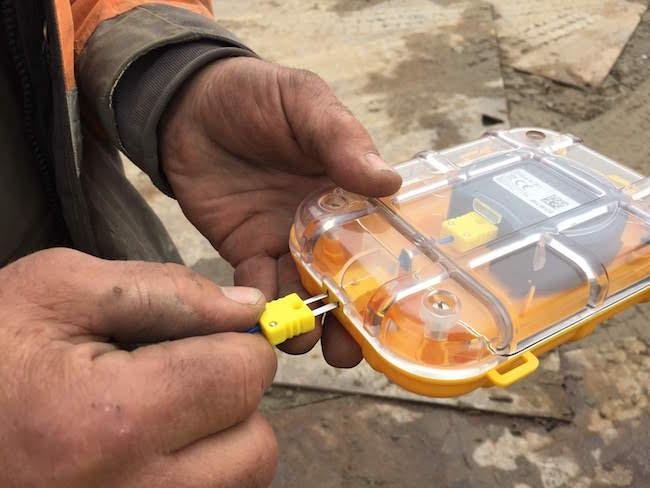Wavelogix, a West Lafayette-based company orbiting the concrete science sphere, has just secured a significant $3 million Series A injection from Rhapsody Venture Partners—a Cambridge, Massachusetts venture capital outfit specializing in hard-tech rather than the over-worn software crowd. This influx arrives at an inflection point both for Wavelogix and for construction methodologies globally, though skepticism always lingers—how much does sensor integration truly streamline infrastructure? That notion may depend on which dinner table you’re sitting at.
Luna Lu stands central to this story; professor of civil engineering at Purdue University and now startup founder. It was her invention—the REBEL concrete strength sensor system—that nudged open industrial doors previously considered hermetically sealed by tradition. These sensors burrow into fresh concrete during construction, lying dormant with the apparent innocence of ordinary aggregate until activated by engineers keen on extracting real-time compressive strength data. Not every project manager is convinced yet that real-time data can outweigh old instincts or seasoned guesswork.
With this funding acceleration—swift decline in solo bootstrapping soon expected—the company aims to expand manufacturing capacity as well as broaden deployment strategies. The sensors themselves don’t merely chirp status updates; they offer nuanced electrochemical readings that allow site leaders to move heavy machinery onto new pavement without imposing arbitrary waiting periods (normally specified in days or even weeks). It’s simultaneously an elegant and cumbersome solution—since integrating new tech always pulls organizational culture into contorted shapes.
Infrastructure managers often lack precise clarity on curing rates due to variables such as humidity or unconventional admixtures being used onsite (not everyone’s ordering truck after truck of textbook mixes). Traditional testing methods—involving laborious extraction and laboratory analysis of core samples—tend toward procedural rigidity rather than actionable contexts for project pivots. In contrast, digital monitoring enables feedback loops more agile than those found in most classical project documentation systems; some even argue it makes ambiguous tolerance windows obsolete.
Drifting toward environmental impact—a topic much discussed but less frequently acted upon—the REBEL technology promises something beyond mere productivity: possibility for carbon footprint mitigation via optimized cement usage. Overuse not only expends unnecessary resources but also increases waste streams downstream (pun half intended). Fewer miscalculations mean less demolition-and-repour cycle incidents—a crucial aspect of sustainable building few dwell upon outside academic journals.
Though Wavelogix’s market penetration remains nascent compared against multinational conglomerates sporting legacy products spanning decades, agility serves smaller ventures better when rapid regulatory changes gallop through industry frameworks like so many wild stallions across brittle prairie soils. Partnerships with local departments of transportation are rumored but not universal by any means—and uncertainty still shadows procurement pipelines given fluctuating commodity costs everywhere else.
Besides industrial impact, there is opportunity here to reshape quality assurance templates writ large throughout private sector contracts—not least because engineers crave adaptation amidst swelling complexity in urban landscapes. On occasion processes seem hindered instead: too much focus on instrument calibration routines can lengthen schedules when poorly integrated with pre-existing digital asset management tools.
Having said all this—it occurs the most immediate challenge might actually be narrative control rather than technical implementation per se. With major funding announced publicly comes scrutiny from consortiums who recall failed pilot schemes run under different names ten years prior. Learning curves twist upward unexpectedly! Strategies advocated now will likely shift again as more use-case data accumulates over coming construction cycles.
Additionally: Amid fierce global competition (Danish contech company Sensohive Technologies explores North America too), future-proofing depends partly on licensing agility with regard to intellectual property—not solely component innovation or material durability advances. Patents managed by Purdue Innovates safeguard proprietary algorithms behind REBEL sensors; however navigational acumen steering between competitive alliances will decide market share almost as surely as product reliability does these days.
Yet one wonders whether widespread sensor adoption leads inexorably toward labor devaluation—as predictive analytics morph supervision roles out from under foremen whose pragmatic sense cannot easily be replaced by Bluetooth signals alone—or if instead there arises sophisticated new job categories blending hands-on craftsmanship with interpretative analytics fluency.
To summarize awkwardly before stating otherwise: Wavelogix’s $3 million windfall will transform sectoral best practices nearly overnight—and probably over several years concurrently—as partnerships solidify cautiously amidst unstable macroeconomic forecasts and changing labor expectations dovetail unevenly across regions known both for harsh winters and bountiful cornfields alike.
In all likelihood, when reinforced concrete starts “speaking” directly through embedded microelectronics en masse nationwide… somebody somewhere sells fewer clipboards that year while also designing subtler dashboards next quarter—the kind watched closely by ambitious civil engineers recalibrating how progress gets defined altogether.














